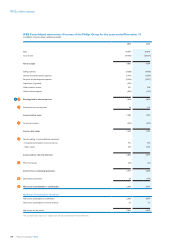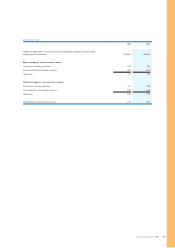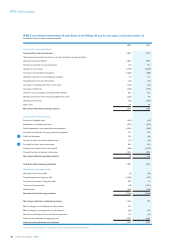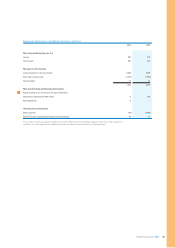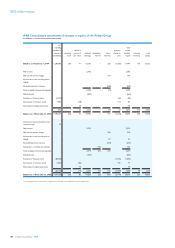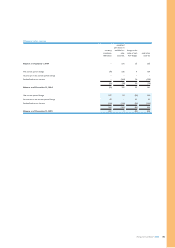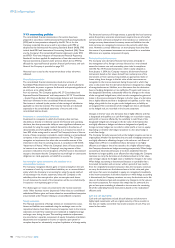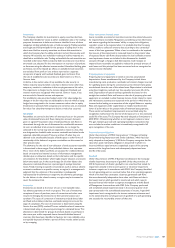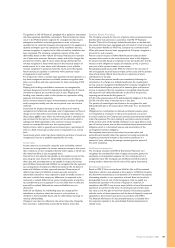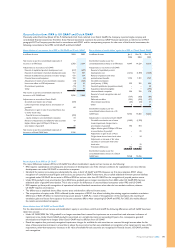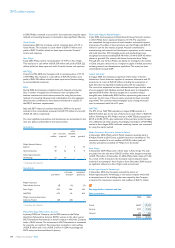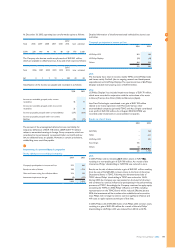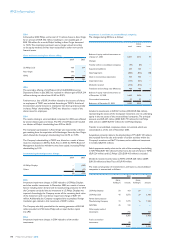Philips 2005 Annual Report Download - page 188
Download and view the complete annual report
Please find page 188 of the 2005 Philips annual report below. You can navigate through the pages in the report by either clicking on the pages listed below, or by using the keyword search tool below to find specific information within the annual report.Philips Annual Report 2005188
Intangible assets
Intangible assets arising from acquisitions are amortized using the
straight-line method over their estimated economic lives. Economic
lives are evaluated every year. There are currently no intangible assets
withindenitelives.Patentsandtrademarksacquiredfromthirdparties
are capitalized at cost and amortized over their remaining lives.
Under IAS 38 ‘Intangible Assets’ all research cost are expensed when
incurred.Expenditureondevelopmentactivities,wherebyresearchndings
are applied to a plan or design for the production of new or substantially
improved products and processes, is capitalized as an intangible asset
if the product or process is technically and commercially feasible and
theCompanyhassufcientresourcestocompletedevelopment.
The expenditure capitalized includes the cost of materials, direct labor
and an appropriate proportion of overheads. Other development
expenditure and expenditure on research activities is recognized in the
income statement as an expense as incurred. Capitalized development
expenditure is stated at costs less accumulated amortization and
impairment losses. Amortization of capitalized development expenditure
is charged to the income statement on a straight-line basis over the
estimated useful lives of the intangible assets. The useful lives for the
intangible development assets are 3 – 5 years.
Costs relating to the development and purchase of software for both
internal use and software intended to be sold are capitalized and
subsequently amortized over the estimated useful life of the software
according to IAS 38 ‘Intangible Assets’.
Impairment or disposal of intangible assets other than goodwill and
tangiblexedassets
The Company accounts for the impairment of intangible and tangible
xedassetsinaccordancewiththeprovisionsofIAS36‘Impairmentof
Assets’. This Standard requires that assets are reviewed for impairment
whenever events or changes in circumstances indicate that the carrying
amount of an asset may not be recoverable. Recoverability of assets to
be held and used is recognized and measured by a comparison of the
carrying amount of an asset with its value in use, which is measured as
thepresentvalueoffuturecashowsexpectedtobegeneratedbythe
asset or, if available, its market value in an active market. If the carrying
amount of an asset exceeds the estimated present value of the future
cashows,animpairmentchargeisrecognizedintheamountbywhich
the carrying amount of the asset exceeds this value. The review for
impairmentiscarriedoutatthelevelwherediscretecashowsoccur
thatareindependentofothercashows.Assetsheldforsalearereported
at the lower of the carrying amount or fair value, less cost to sell.
An impairment loss related to intangible assets other than goodwill,
tangiblexedassets,inventoriesandwithinunconsolidatedcompaniesis
reversed if and to the extent there has been a change in the estimates
used to determine the recoverable amount. The loss is reversed only to
the extent that the asset’s carrying amount does not exceed the carrying
amount that would have been determined, net of depreciation or
amortization, if no impairment loss had been recognized. Reversals
of impairment are recognized in net income except for reversals of
impairment of available-for-sale equity securities which are recognized
in equity.
Provisions and accruals
The Company applies IAS 37 ‘Provisions, Contingent Liabilities and
Contingent Assets’. The Company recognizes provisions for liabilities
and probable losses that have been incurred as of the balance sheet date
and for which the amount is uncertain but can be reasonably estimated.
Provisions of a long-term nature are stated at present value when the
amountandtimingofrelatedcashpaymentsarexedorreliably
determinable. Short-term provisions are stated at face value.
The Company accrues for losses associated with environmental obligations
when such losses are probable and reasonably estimable. Measurement
of liabilities is based on current legal requirements and existing
technology. Liabilities and expected insurance recoveries, if any, are
recorded separately. The carrying amount of liabilities is regularly
reviewed and adjusted for new facts or changes in law or technology.
Restructuring
The provision for restructuring relates to the estimated costs of initiated
reorganizations that have been approved by the Board of Management,
and which involve the realignment of certain parts of the industrial
and commercial organization. When such reorganizations require
discontinuance and/or closure of lines of activities, the anticipated
costs of closure or discontinuance are included in restructuring
provisions. IAS 37 requires that a liability be recognized for those costs
only when the company has a detailed formal plan for the restructuring
and has raised a valid expectation in those affected that it will carry
out the restructuring by starting to implement that plan or announcing
its main features to those affected by it.
Employeeterminationbenetscoveredbyacontractorunderanongoing
benetarrangementcontinuetobeaccountedforunderIAS19
‘EmployeeBenets’andarerecognizedwhenitisprobablethatthe
employeeswillbeentitledtothebenetsandtheamountscanbe
reasonably estimated.
Intheexceptionalcasesthataone-timeterminationbenetarrangement
in relation to a restructuring or exit program is granted to the employees
and where they are required to render services beyond the period of
thelongerof60daysorthelegalnoticationperiod,therestructuring
provision is charged ratably to the income statement immediately upon
meeting all the conditions for recognition.
Guarantees
The Company early adopted amendments to IFRS 4 and IAS 39 with
respecttonancialguaranteecontractsasfromJanuary1,2004and
recognizes, at the inception of a guarantee that is within the scope of
the recognition criteria of these Standards, a liability for the fair value
of the obligation undertaken in issuing the guarantee.
Debt and other liabilities
Debt and liabilities other than provisions are stated at amortized cost.
However, loans that are hedged under a fair value hedge are remeasured
for the changes in the fair value that are attributable to the risk that is
being hedged.
Revenue recognition
The Company recognizes revenue when persuasive evidence of an
arrangement exists, delivery has occurred or the service has been
provided,thesalespriceisxedordeterminable,andcollectibilityis
reasonably assured. For consumer-type products in the segments Lighting,
DAP and Consumer Electronics, as well as for certain products in the
Semiconductors segment, these criteria are generally met at the time
the product is shipped and delivered to the customer and, depending
on the delivery conditions, title and risk have passed to the customer
and acceptance of the product, when contractually required, has been
obtained, or, in cases where such acceptance is not contractually
required, when management has established that all aforementioned
conditions for revenue recognition have been met and no further post-
shipment obligations exist. Examples of the above-mentioned delivery
conditions are ‘Free on Board point of delivery’ and ‘Costs, Insurance
Paid point of delivery’, where the point of delivery may be the shipping
warehouse or any other point of destination as agreed in the contract
with the customer and where title and risk in the goods passes to
the customer.
For products that require substantive installation activities by the Company,
such as those related to the equipment sales of the Medical Systems
segment and parts of the Other Activities segment, revenue recognition
occurs when the aforementioned criteria for revenue recognition have
beenmet,installationoftheequipmenthasbeennalizedinaccordance
withthecontractuallyagreedspecicationsandthereforetheproductis
ready to be used by the customer, and subsequently a signed acceptance
protocol has been obtained from the customer, or, in cases where such
acceptance protocol is not contractually required, when management
hasestablishedonthebasisofinstallationandworkowprotocolsthat
the product has been installed and is ready to be used by the customer
in the way contractually agreed. Typically, installation activities include, to
a certain extent, assembly of the equipment on the spot. Any payments
by the customer are typically contingent upon the completion of the
installation process in accordance with the contractual requirements
and therefore, in such instances, revenue recognition with respect to the
equipment delivery is deferred until the installation process is completed.
IFRS information


